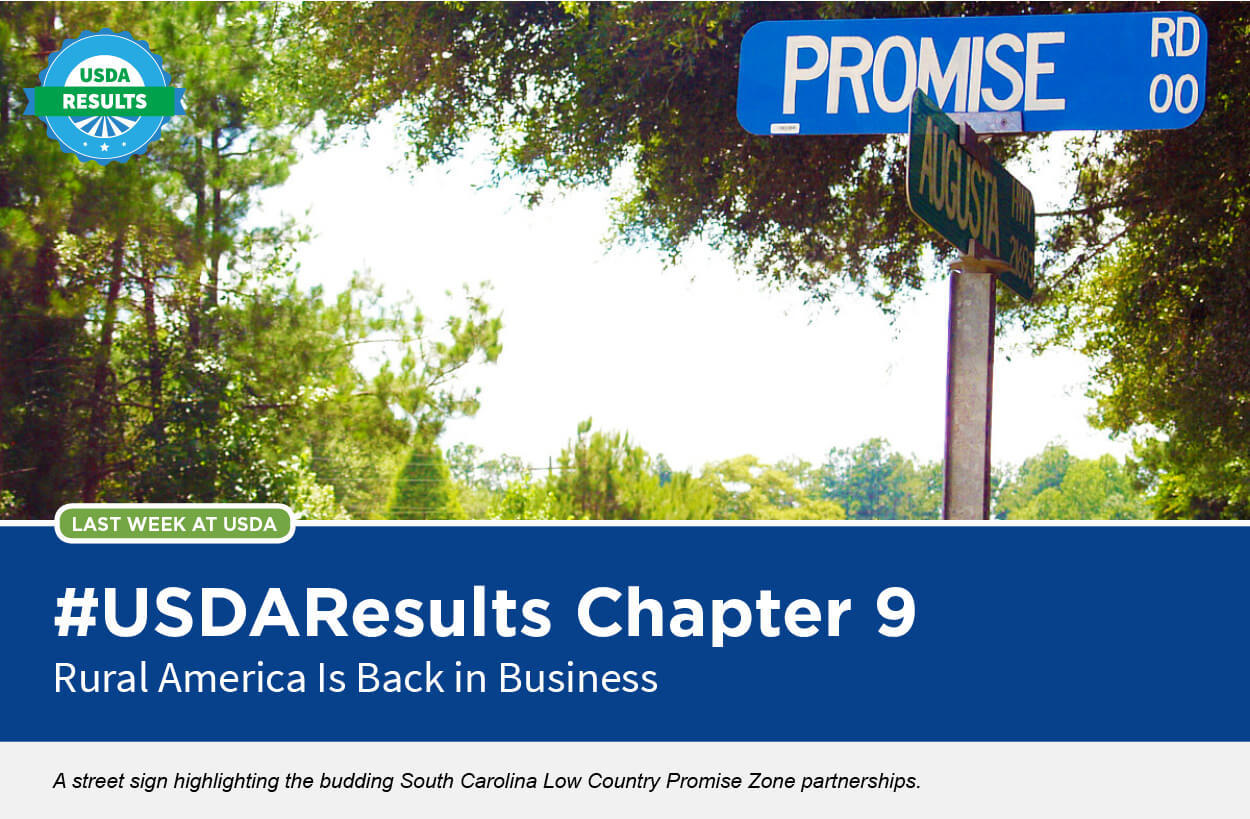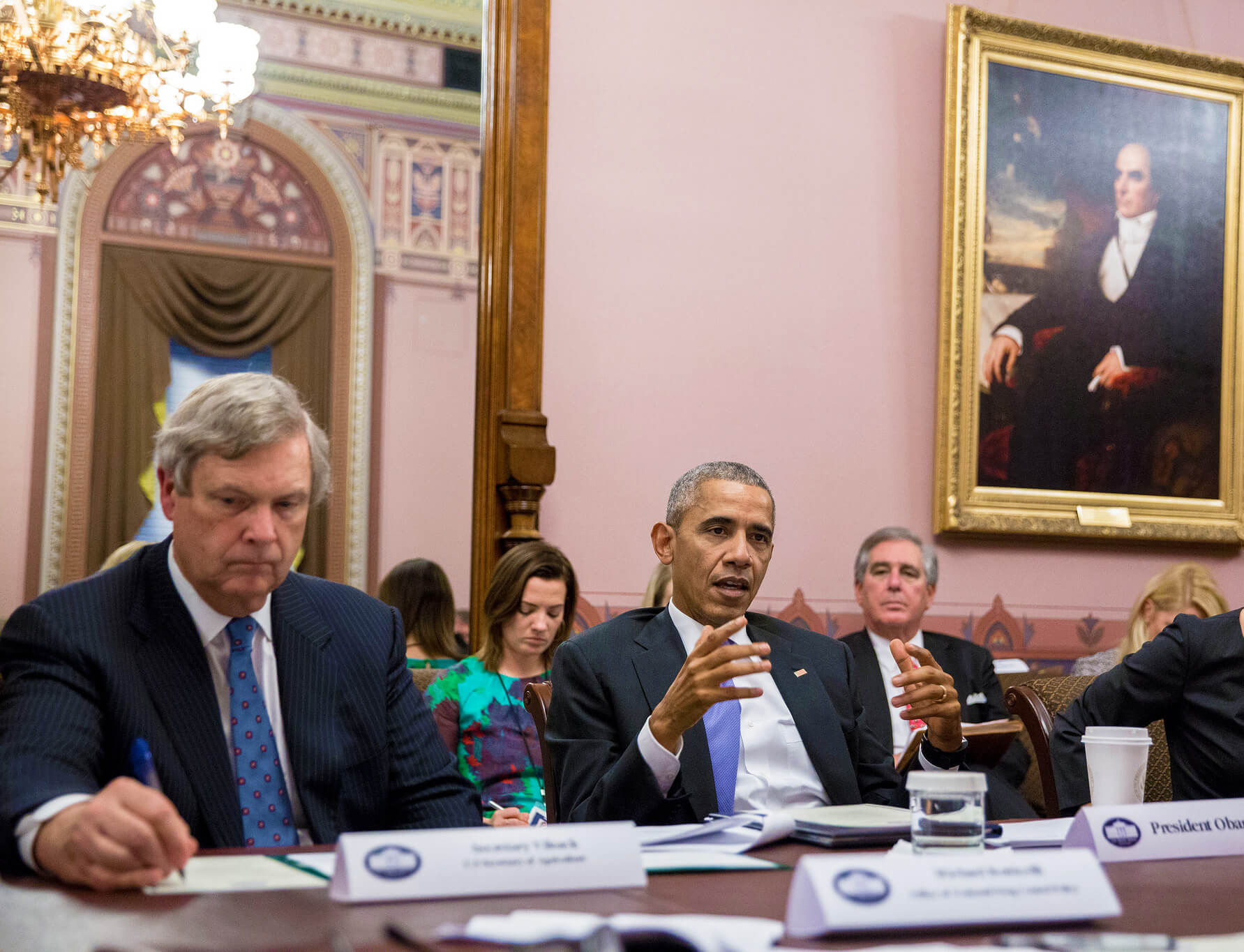



A child’s future prospects should not be determined by the ZIP code she is born in. But too often, rural areas find themselves at the short end of a long stick when it comes to basic services.
Community facilities like schools, libraries, health care facilities, recreational centers and public safety facilities, are important to the people who call that area home. In rural towns in particular, they often serve as the fulcrum of the community, essential to attracting and retaining high impact businesses and young families. Since 2009, we’ve invested in more than 8,350 critical community facilities projects that help ensure even remote areas enjoy the same quality of life services enjoyed by those in urban areas.
Last week, we announced a $54.6 million Community Facilities program loan to the Fulton County Health Center in Wauseon, Ohio, to renovate a hospital that offers treatment for substance misuse disorders. As part of the White House's efforts to increase support for addressing the opioid crisis in rural areas, USDA funds will help construct a 62,220-square-foot medical office building, easing a space shortage and helping attract additional medical specialists to the area. About 80 new jobs are anticipated as a result.
Close by at the Clinton County's Wilmington College, a similar $19.7 million USDA Community Facilities loan in 2013 helped to finance the rehabilitation of Kettering Hall, home of the school's Center for Science and Agriculture. A few short years ago, Wilmington was reeling from the loss of the region's primary employer, which quadrupled the unemployment rate. USDA support is helping turn the tide, and today the community is making a comeback.
In Red Lake, Minnesota, USDA’s Community Facilities program will provide funding to help the Red Lake Band of Chippewa Indians with infrastructure for four essential community facilities, ranging from public safety to health care and including funds to construct a new chemical dependency treatment center in wake of the rural opioid epidemic. Since 2009, USDA has significantly expanded its support for Tribes and Tribal communities, providing $3.1 billion in Rural Development programs and services. You can read about the projects in Red Lake on our website.
Join us throughout the month of September as we tell the important story of eight years of significant and transformative investments across the nation that have empowered rural America to continue leading the way, strengthening America’s economy, as well as the small towns and rural communities that so many call home. Follow along on usda.gov, on the USDA blog and by using #USDAResults, or catch up on Chapter IX on our Medium site.



In January 2016, President Obama asked me to lead an interagency federal effort focused on the rural heroin and prescription opioid crisis. Throughout the month you can join us as we tell the important story of how eight years of significant and transformative investments across the nation have empowered rural America to continue leading the way, strengthening America’s economy, as well as the small towns and rural communities that so many call home.

Utah rancher Bill Kennedy worked with NRCS through SGI to improve his working rangelands for sage grouse and livestock.

Farmers can help ensure there is enough agricultural labor in the United States at critical times in the production cycles by taking part in the Agricultural Labor survey.

Fall is perhaps one of the most beautiful times of the year in North America and every year the U.S. Forest Service celebrates with the launch of our Fall Colors Webpage.

Seeing is believing
Fall is perhaps one of the most beautiful times of the year in North America and every year the U.S. Forest Service celebrates with the launch of our Fall Colors Webpage.
Ranchers Continue to Lead Successful Conservation Efforts for Sage Grouse
This past April, we woke up at 3 a.m. and made our way to a blind amid an expanse of sagebrush on a ranch in central Montana. When the sun rose that morning, I saw my first sage grouse–actually, I got to see more than 100 of them!–when the birds arrived at the lek site for their famous tail-shaking springtime courtship dance.
Students Get Involved in School Lunch through School Lunch Advisory Councils
There are many ways Team Nutrition schools are involving students in the development of school meal menus and health promotion activities. These activities can help schools offer nutritious foods in a manner that appeals to children and can help students learn about nutrition and school foodservice.
Flooding: A Checklist for Small and Very Small Meat, Poultry and Egg Inspection Processing Plants
Rivers rise. The ground is saturated. Levees fail. Floods happen, and they happen beside rivers, along the coasts, in deserts and in city streets. Flooding might be a fact of nature but that does not mean you have to lose your business and possessions to flood waters.
New Allowances for Including a “Non-GMO” Statement on Certified Organic Meat and Poultry Products
Organic meat and poultry producers can now use a streamlined process to get approval for labels verifying that their products do not include genetically engineered (GE) ingredients. These products may also now use a “Non-GMO” label claim. Because of this, we’re updating a previous blog from our “Organic 101” series.
Strengthening U.S. Farm Labor through Surveys
Throughout the course of the year, hired labor makes planting and harvesting of America’s farmland possible. On my family’s Illinois farm, we relied on both paid and unpaid friends and family to bring in our hay. Nearby farmers however relied on seasonal migrant labor to harvest vegetables.
An Inside Look: Anatomy of a Team Up Workshop
If you haven’t heard the buzz, the USDA Food and Nutrition Service’s expansion of the Team Up for School Nutrition Success initiative is in full swing, with 20 completed trainings and 14 more scheduled for 2016. Team Up offers a unique learning experience that enhances schools’ food service operations through training and peer-to-peer mentorship to school nutrition professionals looking to maintain a healthy environment and encourage strong student meal program participation.
2016 GODAN Summit: A Large Display of USG Support for Agriculture and Nutrition Open Data
Open agriculture and nutrition data is a powerful tool for long-term sustainable development. The Global Open Data for Agriculture and Nutrition (GODAN) initiative – comprising more than 350 international organizations representing governments, donors, businesses, and not-for-profits – continues to be a leader in advocating for the adoption of open data policies.
Be a Fire Wise know it all
You’ve heard this from us during previous fire seasons, and you’ll continue to hear it from us every fire season: You can never be Fire Wise enough. And, with this being National Preparedness Month, you’re going to hear it a lot.
Two Small Growers Form Unusual Partnership
When you meet farmers Gordon Bednarz and Brenda Sullivan, two words come to mind—polar and opposites. But the pair has joined forces in a unique way – sharing land and growing food as partners, without a formal partnership.

New USDA Local Initiatives to Address Rural Opioid Epidemic
As part of Prescription Opioid and Heroin Epidemic Awareness Week, Agriculture Secretary Vilsack has announced some new initiatives. (Gary Crawford, Loretta Lynch, Michael Botticelli and Tom Vilsack)
Actuality: More USDA Drug Related Meetings in Rural Areas This Month
Agriculture Secretary Tom Vilsack in a phone conference with reporters from the White House talking about a continuing series of meetings USDA will be hosting this month in rural areas. **note to broadcasters. Meetings are Sept. 19 in Tolland, Connecticut, Sept. 20 in Brighton, Colorado, Sept. 26 in Grants Pass, Oregon and Sept. 29 in Fayetteville, North Carolina***
Actuality: A New USDA Move to Provide More Housing for People in Recovery
Agriculture Secretary Tom Vilsack in a phone conference with reporters from the White House talking about the latest USDA move to provide more housing for people in drug recovery.
Restoration Strategy For Gulf Coast Ag Lands And Ecosystems
A three year strategy announced Monday aims to improve water quality and ecosystem health along the five state Gulf Coast region. (Rod Bain and Natural Resources Conservation Service Chief Jason Weller)

Rural America Has Already Begun to Rebound (NY Times)
Despite concerns about the fate of rural America, a number of key benchmarks show these areas have been growing economically since 2014. Many were surprised when the Census Bureau released data last Thursday showing median household income in non-metro areas of the United States had increased by 3.4 percent in 2015 and poverty rates had fallen.
Parent of Colorado drug abuser attends White House meeting (Denver Post)
A Colorado woman whose daughter has struggled for years with drug addiction met Monday with Obama administration officials to discuss federal efforts to counteract a narcotics epidemic that authorities have described as an ongoing crisis. Karen Walker of Woodland Park was one several parents invited to speak with U.S. Agriculture Secretary Tom Vilsack and Michael Botticelli, the director of the Office of National Drug Control Policy, during a morning meeting in the Roosevelt Room of the White House.
Obama administration launches week-long blitz on heroin and opioid crisis (USA Today)
The Obama administration launched a week-long blitz on the heroin and opioid addiction crisis Monday, announcing new initiatives and calling on Congress to fully fund the effort with $1.1 billion.
USDA Announces Nearly $13 Million in Funding for Four Tribal Projects in Minnesota (Red Lake News Nation)
U.S. Secretary of Agriculture Tom Vilsack today announced funding to help the Red Lake Band of Chippewa Indians with infrastructure for four essential community facilities, ranging from public safety to healthcare and including funds to construct a new chemical dependency treatment center in wake of the rural opioid epidemic. Funding is provided through USDA's Community Facilities program.
USDA invests to expand access to health care (Farm Futures)
USDA is investing in 18 projects in 16 states to use communications technology to expand access to health care, substance misuse treatment and advanced educational opportunities.
"These investments will help provide better health care and educational opportunities for rural residents," said Agriculture Secretary Tom Vilsack. "Hospitals, schools and training centers across the country are successfully using telecommunications to deliver quality educational and medical services. Telemedicine, for example, can help treat patients who are struggling with opioid and other substance use disorders that disproportionately affect rural areas by allowing rural hospitals to connect with resources in other health care facilities across the country to better diagnose and treat individuals."
N.J. advocate joins Obama push to fund opioid addiction treatment (New Jersey)
Kevin Meara is no stranger to the pain of drug addiction. His son, KC, died of a heroin overdose in 2008. He and his wife Maryann then started City of Angels, a nonprofit group helping individuals with drug addiction. His advocacy in the field led to a White House invitation Monday where the Hamilton Township resident and 11 others who lost loved ones to drug addiction met with Michael Botticelli, director of national drug control policy, and Agriculture Secretary Tom Vilsack, who experienced the pain of addiction first-hand with a mother and uncle who were alcoholics.
White House Launches Opioid Abuse Campaign Amid Reports Drug Companies Fighting Effort to Limit Prescription Painkillers (WDET)
The Obama Administration is launching a national campaign this week to highlight the federal government’s fight to combat heroin and opioid addiction. And the White House is pressing Congress to fund the efforts. A new investigation by the Associated Press and the Center for Public Integrity finds that some pharmaceutical companies and advocacy groups are lobbying state lawmakers, rather than their federal counterparts, to fight limits on prescription painkillers.
USDA Funds Distance Learning, Telemedicine in 16 States (US Ag Net)
Agriculture Secretary Tom Vilsack Monday announced that USDA is investing in 18 projects in 16 states to use communications technology to expand access to health care, substance misuse treatment and advanced educational opportunities. "These investments will help provide better health care and educational opportunities for rural residents," Vilsack said. "Hospitals, schools and training centers across the country are successfully using telecommunications to deliver quality educational and medical services.
Three Alabama counties to get federal assistance with rural drug problem (Alabama Media Group)
A grant from the U.S. Department of Agriculture will help train first responders in three rural Alabama counties how to treat patients who have overdosed on heroin and opioid painkillers, according to U.S. Secretary of Agriculture Tom Vilsack. The Alabama Fire College and Personnel Standards Commission will receive $115,282 to provide distance learning to first responders in Tuscaloosa, Lauderdale and Washington Counties, Vilsack said. They will learn how to identify opioid overdoses and treat them with a highly effective antidote.
USDA ramps up battle against rural opioid abuse (Agripulse)
Agriculture Secretary Tom Vilsack today announced new USDA initiatives to counter an epidemic of opioid and heroin abuse that has killed thousands of Americans, with a disproportionate impact on rural communities. The initiatives, aimed at strengthening outreach and education resources at the local level, were announced as President Obama proclaimed this week Prescription Opioid and Heroin Epicdemic Awareness week.
USDA describes $328M oil spill restoration plan for Gulf (Associated Press)
The U.S. Department of Agriculture says it’s focusing conservation programs along the Gulf of Mexico in a $328 million plan to help recovery from the 2010 oil spill. Undersecretary Robert Bonnie says the agency will use that focus through 2018 as it helps coastal producers plan improvements to improve water quality and improve coastal ecosystems under several Farm Bill programs.
Vilsack: USDA can boost rural communities (Wilmington News Journal)
The role government can play to strengthen America’s rural areas was stressed during US Agriculture Secretary Tom Vilsack’s visit to Wilmington College Thursday. Vilsack toured the college’s newly upgraded and expanded Center for the Sciences and Agriculture, and the facility’s agriculture and science classrooms and laboratories.
Fulton Co. health center gets $54.6M U.S. loan (Toledo Blade)
The Fulton County Health Center received a $54.6 million loan from the U.S. Department of Agriculture, which will be used in part to build a medical office building next to the center. Patti Finn, chief executive officer of the Fulton County Health Center, said the new building will create space for additional physicians including primary care, family medicine, obstetrics, and gynecology.


|

